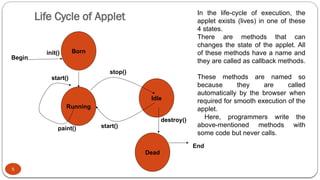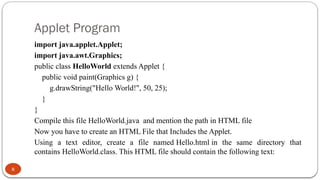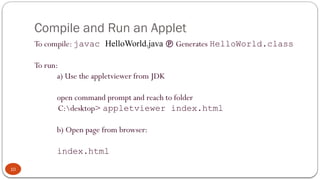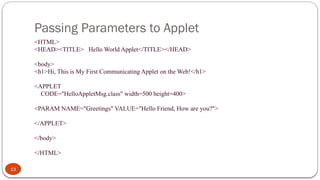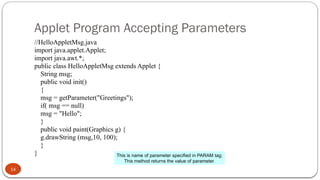Applets in Java. Learn java program with applets
- 1. DEPARTMENT OF COMPUTER SCIENCE & ENGINEERING Subject Name: Java Programming Topics Covered: Java Applets 1 Name of the School: School of Computer Science and Engineering Course Code: E1UC307C Course Name:Java Programming Faculty Name: Programe Name:
- 2. Types of Java Application 2 1. Stand alone application(Java application) 2. Web Application( Applet & JSP/Servlet) Web applications are the applications users can use through a browser. Standalone applications are known as Desktop/ Offline applications and can be accessed offline. Java applications Run in stand-alone mode No additional software required (such as a Web browser) Java applets Compiled Java class files Run within a Web browser (or an appletviewer) Loaded from anywhere on the Internet
- 3. Applet 3 An Applet in Java is a small application that runs within a web browser or an applet viewer. Applets are written in Java and are typically used to provide interactive features in a web page, such as animations, games, or interactive forms. A main() method is not invoked on an applet, and an applet class will not define main(). Applets are designed to be embedded within an HTML page. Here is a basic example of how to create an applet in Java: Steps to Create a Java Applet: 1.Import the necessary packages. 2.Extend the Applet class. 3.Override the init(), start(), stop(), and destroy() methods as needed. 4.Use the paint() method to draw content on the applet window. 5.Create an HTML file to embed the applet in a webpage (for older browsers).
- 4. Life Cycle Methods of Applet 4 Following are the methods for a full applet cycle. init() method start() method paint() method stop() method destroy() method
- 5. Life Cycle of Applet 5 Applet Life Cycle Born Running Idle Dead Begin init() start() paint() stop() start() destroy() End In the life-cycle of execution, the applet exists (lives) in one of these 4 states. There are methods that can changes the state of the applet. All of these methods have a name and they are called as callback methods. These methods are named so because they are called automatically by the browser when required for smooth execution of the applet. Here, programmers write the above-mentioned methods with some code but never calls.
- 6. Life Cycle steps 6 Four methods in the Applet class give you the framework on which you build any applet: init: This method is intended for whatever initialization is needed for your applet. It is called after the param tags inside the applet tag have been processed. start: This method is automatically called after the browser calls the init method. It is also called whenever the user returns to the page containing the applet after having gone off to other pages. stop: This method is automatically called when the user moves off the page on which the applet sits. It can, therefore, be called repeatedly in the same applet. destroy: This method is only called when the browser shuts down normally. Because applets are meant to live on an HTML page, you should not normally leave resources behind after a user leaves the page that contains the applet. paint: Invoked immediately after the start() method, and also any time the applet needs to repaint itself in the browser. The paint() method is actually inherited from the java.awt.
- 7. 7 init() start() stop() destroy() paint do other work init and destroy are only called once each start and stop are called whenever the browser enters and leaves the page do some work is code called by your listeners paint is called again when the applet needs to be repainted
- 8. Applet Program 8 import java.applet.Applet; import java.awt.Graphics; public class HelloWorld extends Applet { public void paint(Graphics g) { g.drawString("Hello World!", 50, 25); } } Compile this file HelloWorld.java and mention the path in HTML file Now you have to create an HTML File that Includes the Applet. Using a text editor, create a file named Hello.html in the same directory that contains HelloWorld.class. This HTML file should contain the following text:
- 9. Embedding Applet in Web page 9 <HTML> <HEAD> <TITLE> Hello World Applet </TITLE> </HEAD> <body> <h1>Hi, This is My First Java Applet on the Web!</h1> <APPLET CODE="HelloWorld.class" width=500 height=400></APPLET> </body> </HTML>
- 10. Compile and Run an Applet 10 To compile: javac HelloWorld.java Generates HelloWorld.class To run: a) Use the appletviewer from JDK open command prompt and reach to folder C:desktop> appletviewer index.html b) Open page from browser: index.html
- 11. Hello World.java 11 import java.applet.Applet; import java.awt.*; public class GraphicsDemo extends Applet{ public void paint(Graphics g){ g.setColor(Color.red); g.drawString("Welcome",50, 50); g.drawLine(20,30,20,300); g.drawRect(70,100,30,30); g.fillRect(170,100,30,30); g.drawOval(70,200,30,30); g.setColor(Color.pink); g.fillOval(170,200,30,30); g.drawArc(90,150,30,30,30,270); g.fillArc(270,150,30,30,0,180); } }
- 12. Displaying Image in Applet 12 import java.awt.*; import java.applet.*; public class DisplayImage extends Applet { Image picture; public void init() { picture = getImage(getDocumentBase(),“abc.jpg"); } public void paint(Graphics g) { g.drawImage(picture, 30,30, this); } }
- 13. Passing Parameters to Applet 13 <HTML> <HEAD><TITLE> Hello World Applet</TITLE></HEAD> <body> <h1>Hi, This is My First Communicating Applet on the Web!</h1> <APPLET CODE="HelloAppletMsg.class" width=500 height=400> <PARAM NAME="Greetings" VALUE="Hello Friend, How are you?"> </APPLET> </body> </HTML>
- 14. Applet Program Accepting Parameters 14 //HelloAppletMsg.java import java.applet.Applet; import java.awt.*; public class HelloAppletMsg extends Applet { String msg; public void init() { msg = getParameter("Greetings"); if( msg == null) msg = "Hello"; } public void paint(Graphics g) { g.drawString (msg,10, 100); } } This is name of parameter specified in PARAM tag; This method returns the value of parameter.
- 15. Output 15
- 16. Interactive Applet Program 16 import java.applet.Applet; import java.awt.*; public class SumNumsInteractive extends Applet { TextField text1, text2; public void init() { text1 = new TextField(10); text2 = new TextField(10); text1.setText("0"); text2.setText("0"); add(text1); add(text2); } public void paint(Graphics g) { int num1 = 0; int num2 = 0; int sum; String s1, s2, s3; g.drawString("Input a number in each box ", 10, 50); try { s1 = text1.getText(); num1 = Integer.parseInt(s1); s2 = text2.getText(); num2 = Integer.parseInt(s2); } catch(Exception e1) {}
- 17. Displaying Numeric Value 17 //SumNums.java import java.applet.Applet; import java.awt.*; public class SumNums extends Applet { public void paint(Graphics g) { int num1 = 10; int num2 = 20; int sum = num1 + num2; String str = "Sum: "+String.valueOf(sum); g.drawString (str,100, 125); } }
- 18. References: 18 https://www.geeksforgeeks.org/ https://www.javatpoint.com/exception-handling-in-java https://www.tutorialspoint.com/java/java_exceptions.htm The complete reference, eleventh edition, available at: https://gfgc.kar.nic.in/sirmv-science/GenericDocHandler/138-a2973dc6-c024 -4d81-be6d-5c3344f232ce.pdf
- 19. 19 Thank you




